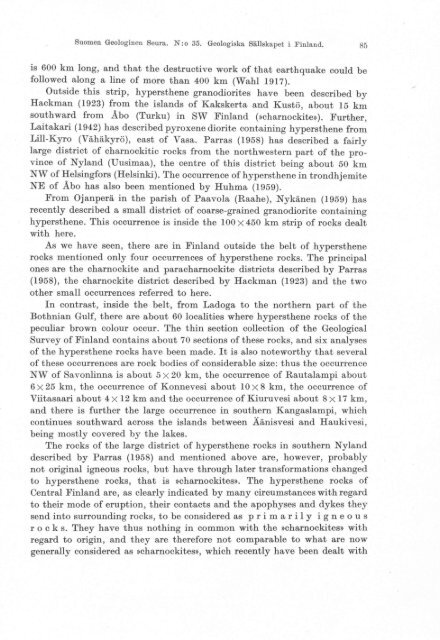COMMISSION GEOLOGIOUE - Arkisto.gsf.fi
COMMISSION GEOLOGIOUE - Arkisto.gsf.fi
COMMISSION GEOLOGIOUE - Arkisto.gsf.fi
Create successful ePaper yourself
Turn your PDF publications into a flip-book with our unique Google optimized e-Paper software.
Suomen Geologinen Seura. N: 0 35. Geologiska Sällskapet i Finland. 85<br />
is 600 km long, and that the destructive work of that earthquake could be<br />
followed along a line of more than 400 km (Wahl 1917).<br />
Outside this strip, hypersthene granodiorites have been described by<br />
Hackman (1923) from the islands of Kakskerta and Kustö, about 15 km<br />
southward from Abo (Turku) in SW Finland (»charnockite»). Further,<br />
Laitakari (1942) has described pyroxene diorite containing hypersthene from<br />
Lill-Kyro (Vähäkyrö), east of Vasa. Parras (1958) has described a fairly<br />
large district of charnockitic rocks from the northwestern part of the province<br />
of Nyland (Uusimaa), the centre of this district being ab out 50 km<br />
NW of Helsingfors (Helsinki). The occurrence of hypersthene in trondhjemite<br />
NE of Abo has also been mentioned by Huhma (1959).<br />
From Ojanperä in the parish of Paavola (Raahe), Nykänen (1959) has<br />
recently described a small district of coarse-grained granodiorite containing<br />
hypersthene. This occurrence is inside the 100 X 450 km strip of rocks dealt<br />
with here.<br />
As we have seen, there are in Finland outside the belt of hypersthene<br />
rocks mentioned only four occurrences of hypersthene rocks. The principal<br />
ones are the charnockite and paracharnockite districts described by Parras<br />
(1958), the charnockite district described by Hackman (1923) and the two<br />
other small occurrences referred to here.<br />
In contrast, inside the belt, from Ladoga to the northern part of the<br />
Bothnian Gulf, there are about 60 localities where hypersthene rocks of the<br />
peculiar brown colour occur. The thin section collection of the Geological<br />
Survey of Finland contains ab out 70 sections of these rocks, and six analyses<br />
of the hypersthene rocks have been made. It is also noteworthy that several<br />
of these occurrences are rock bodies of considerable size: thus the occurrence<br />
NW of Savonlinna is about 5 X 20 km, the occurrence of Rautalampi about<br />
6 X 25 km, the occurrence of Konnevesi about 10 X 8 km, the occurrence of<br />
Viitasaari about 4 X 12 km and the occurrence of Kiuruvesi about 8 X 17 km,<br />
and there is further the large occurr€mce in southern Kangaslampi, which<br />
continues southward across the islands between Äänisvesi and Haukivesi,<br />
being mostly covered by the lakes.<br />
The rocks of the large district of hypersthene rocks in southern Nyland<br />
described by Parras (1958) and mentioned above are, however, probabiy<br />
not original igneous rocks, but have through later transformations changed<br />
to hypersthene rocks, that is »charnockites». The hypersthene rocks of<br />
Central Finland are, as clearly indicated by many circumstances with regard<br />
to their mode of eruption, their contacts and the apophyses and dykes they<br />
send into surrounding rocks, to be considered as pr im ar i I y i g neo u s<br />
r 0 c k s. They have thus nothing in common with the »charnockites» with<br />
regard to origin, and they are therefore not comparable to what are now<br />
generally considered as »charnockites», which recently have been dealt with
















